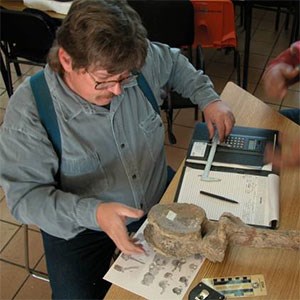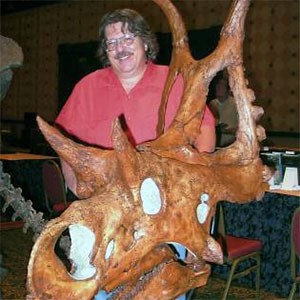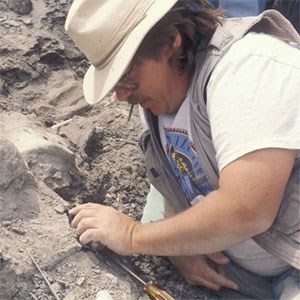Part of a series of articles titled Meet A Paleontologist.
Article
Jim Kirkland, Utah Geological Survey

State Paleontologist of Utah, Utah Geological Survey
What is your job, and what do you study?
I'm the State Paleontologist of Utah with the Utah Geological Survey. It is my job to make sure that Utah's fabulous fossil record is protected and used for learning about the history of life, education, and the wonder of it all. I also promote Utah's fossil record for tourism and as a natural laboratory for all our nations scientists and universities. Basically, I'm Utah's paleo-cheerleader and I get to work on a wide variety of projects. I issue permits to qualified scientists working on Utah state lands and work with other government agencies to coordinate our efforts .And best of all I get to make new discoveries and report them to the public in scientific papers, lectures, exhibits, on the internet, and through documentaries.

What are you working on now?
I'm mostly working on new dinosaurs from the Early Cretaceous Cedar Mountain Formation. These rocks have several successive dinosaur faunas consisting of long-necked sauropods, armored ankylosaurs, bipedal, thumb-spike iquanodonts, and a variety of small and large meat-eating dinosaurs of which Utahraptor is the most famous. I love ankylosaurs and I am working on a constructing a new family tree. Additionally we have a new site, where a "pack" of large and small Utahraptors got stuck, while feeding on an iguanodont. There are so many intertwined skeletons, that we have to take them all out together in a block of rock weighing many tons for which we are trying to fine help with a very large helicopter.

Where did you go to school? What were some of your favorite classes that you took?
I grew up on the coast in Massachusetts, where I got to observe the edge of our continent over many years and where I had the opportunity to visit many of the great museums in the region. I got poor advisement in high school and was told to go to a "school of mines" to learn about paleontology. So after high school I went to the New Mexico Institute of Mining and Technology in Socorro, New Mexico and while not great for paleontology, it was great as a place to learn geology. Additionally it forced me to learn how to organize and raise money, as I formed a paleontology club and put together student expeditions to famous fossil collecting areas. From there I went to earn my Masters degree at Northern Arizona University in Flagstaff, Arizona, where I researched the paleontology of the marine Cretaceous on the Navajo and Hopi Indian Reservations. I began a long relationship with the Museum of Northern Arizona, where all my fossil collections from my graduate school days are kept. I was here that I also developed many of my skills conducting field paleontology and collecting important skeletal fossils. From here I went to the University of Colorado, where I continued research marine Cretaceous fossils on the tribal lands of Arizona for my doctoral project. Graduate school was the very best time in my life as I had opportunities to work with great scientists from all over at sites across the southwestern United States and Mexico from the dawn of the "Age of Dinosaurs" until the final extinction. I loved my classes in both biology and geology, but Dr. Erle Kauffman's "Biostratigraphy" class drove home that the study of evolution provides a basis by which to construct the relative history of Earth. Today, I simply use large fossils (dinosaurs) as a means of studying Earth History.
Was there an experience you had that made you realize you wanted to be a paleontologist?
Way back in 1959, when I was five my dad bought a set of dinosaur figurines and ruined me for life. When I learned that these bizarre creatures had actually live long ago and were huge by modern standards, I was hooked.
What is your most memorable experience working with fossils?
In 1996, I had the honor of moderating the dinosaur session at the annual meeting of Society of Vertebrate Paleontology at the American Museum of Natural History in New York. I was in the hallway talking with Professor John Ostrom of Yale University, who had been most helpful to me in my early years of studying Utahraptor and ankylosaurs, When Drs. Phil Currie and Pei-ji Chen approached with a folder of large images of a new small meat-eating dinosaur from Liaoning, China. Now Dr. Ostrom was one of the foremost proponents that dinosaurs were warm blooded and gave rise to birds; even going so far as speculate that small-bird-like dinosaurs developed feathers for insulation. Professor Chen had just shown Phil pictures of the first known dinosaur with preserved proto-feathers Sinosauropteryx prima; and Phil knew Prof. Ostrom should see this immediately. Now, I have had the opportunity to visit numerous feathered dinosaur site and see newly discovered, undescribed feathered dinosaurs on numerous trips to Liaoning, China, but nothing pulls at my heart more than the memory of witnessing the tears in John Ostrom's eyes on seeing his life's work validated there in the halls of the AMNH.
Do you have any advice for aspiring paleontologists?
If you are wanting to be a paleontologist take all the science courses you can, particularly in biology and geology. Learn to be think critically, examine the evidence and separate facts from opinions. This critical in science and in life. Learn to write well, keep a journal, and keep your eyes open to the world around you, recording what you see in sketches and words. Learning to distill or simplify your observations is critical in any area of natural history like paleontology and one of the first rules is the that the "Present is the key to the past." Additionally, where your science and math classes provide you with the tools to do science, the ability to write and illustrate is critical to your documenting and presenting your discoveries.
And finally, never say die. For while the opportunities to make a living doing paleontology appear to be few, there is "more than one way to skin a cat." As opposed to a research paleontology in a university or museum, perhaps you are better suited be a preparator (extracting the fossil out of the rock), a collections manager (making sure the fossils and the records about them are available to future researchers), an illustrator (illustrating both the fossils and reconstructing the animal in life), writing books and popular articles (for both adults and kids), sculpting and fabricating (not just sculptures of extinct animals, but missing bones for skeletal reconstructions, cast and mold maker (replicating fossils for exhibits and gift shops), the list goes on and on. Almost all our different skills can contribute to paleontology.
Last updated: July 26, 2018
